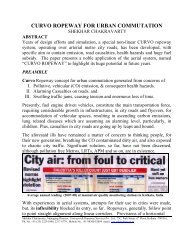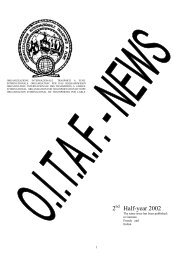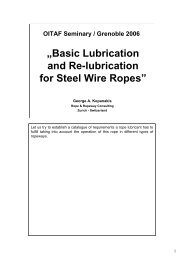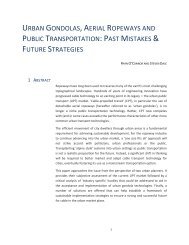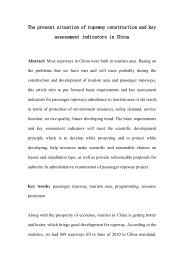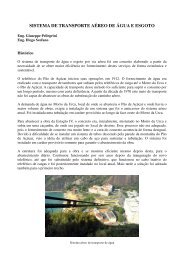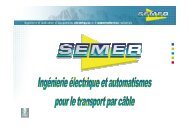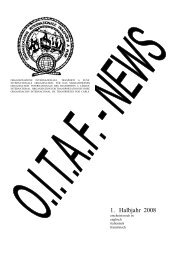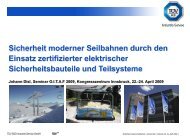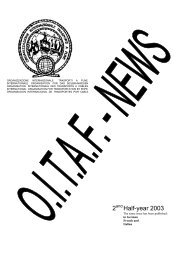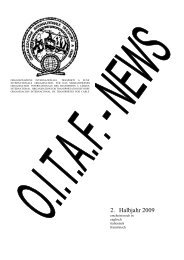7 and 8 strand ropes : applications in ropeways - OITAF
7 and 8 strand ropes : applications in ropeways - OITAF
7 and 8 strand ropes : applications in ropeways - OITAF
You also want an ePaper? Increase the reach of your titles
YUMPU automatically turns print PDFs into web optimized ePapers that Google loves.
7 <strong>and</strong> 8 str<strong>and</strong> <strong>ropes</strong> :<br />
<strong>applications</strong> <strong>in</strong> <strong>ropeways</strong>
Haul<strong>in</strong>g rope package<br />
The long term rope properties depend by:<br />
•Rope construction selection<br />
•Proper fiber core support<br />
•Low stretch<br />
•Reliable splice<br />
All these tasks must be carefully considered<br />
dur<strong>in</strong>g design, manufacture <strong>and</strong> <strong>in</strong>stallation<br />
of each wire rope.
Haul<strong>in</strong>g rope <strong>in</strong>terfaces<br />
The load is supported by the l<strong>in</strong>e rollers.<br />
α<br />
Rope<br />
Sheave<br />
D<br />
P<strong>in</strong><br />
Arm<br />
L<br />
Center p<strong>in</strong><br />
Each tower may conta<strong>in</strong>s several roller pairs.
Haul<strong>in</strong>g rope <strong>in</strong>terfaces<br />
The better roundness of 7 str<strong>and</strong> rope<br />
reduce the amplitude of the roller<br />
movements.<br />
This will improve the passenger comfort.<br />
This will also reduce the occurrence of<br />
breakages of the <strong>in</strong>stallation structures<br />
due to high frequency fatigue.<br />
Rope profiles
Haul<strong>in</strong>g rope <strong>in</strong>terfaces<br />
The <strong>ropes</strong> roundness can be compared<br />
by their profiles.<br />
The scheme below is a magnified plot of<br />
the profiles of <strong>ropes</strong> with 6, 7, <strong>and</strong> 8<br />
str<strong>and</strong>s.<br />
8 str<strong>and</strong> rope 7 str<strong>and</strong> rope 6 str<strong>and</strong> rope<br />
-25% -40%
Haul<strong>in</strong>g rope <strong>in</strong>terfaces<br />
The particular construction of the rope extend the contact po<strong>in</strong>ts with<br />
the sheaves therefore this rope will improve the rollers’ l<strong>in</strong><strong>in</strong>g lifetime<br />
S<strong>in</strong>ce flexibility depends ma<strong>in</strong>ly by the number of str<strong>and</strong>s, this rope<br />
will also allow to adopt smaller rollers <strong>in</strong> respect to other 6 str<strong>and</strong><br />
<strong>ropes</strong>.<br />
6 str<strong>and</strong>s 7 str<strong>and</strong>s<br />
Str<strong>and</strong> diameter<br />
Core diameter<br />
Str<strong>and</strong> diameter
Haul<strong>in</strong>g rope <strong>in</strong>terfaces<br />
The smaller str<strong>and</strong>s allow to adopt str<strong>and</strong> constructions made with a<br />
few number of wires .<br />
This improves the stability of the rope aga<strong>in</strong>st the clamp<strong>in</strong>g pressure<br />
<strong>and</strong> improve the splice reliability.<br />
The rope deformation at the tucks will be much less <strong>in</strong> respect to 6<br />
str<strong>and</strong> <strong>ropes</strong>
Haul<strong>in</strong>g rope design criteria<br />
General rules<br />
All the <strong>ropes</strong> for haul<strong>in</strong>g-carry<strong>in</strong>g operation must have a fiber core <strong>in</strong><br />
order to allow splices. Therefore the <strong>ropes</strong> must be produced with a<br />
s<strong>in</strong>gle layer of str<strong>and</strong>s over a core.<br />
The number of str<strong>and</strong>s must be not less than 6 to allow the splice (with a<br />
lower number of str<strong>and</strong>s, the core diameter would be smaller than those<br />
of the outer str<strong>and</strong>).
Haul<strong>in</strong>g rope design criteria<br />
Characteristic Goal Obta<strong>in</strong>ed by<br />
High metallic area To <strong>in</strong>crease load capacity 6 outer str<strong>and</strong>s<br />
Roundness To prevent vibrations <strong>in</strong>creased number of outer str<strong>and</strong>s<br />
Extended surface To reduce the pressure over the rollers <strong>and</strong> sheaves <strong>in</strong>creased number of outer str<strong>and</strong>s<br />
Flexibility<br />
To <strong>in</strong>crease the contact surface with the grips<br />
To reduce bend<strong>in</strong>g stresses<br />
Large outer area To reduce the rope wear <strong>in</strong>creased number of outer str<strong>and</strong>s<br />
Suitability for splic<strong>in</strong>g To prevent knots oversize <strong>in</strong>creased number of outer str<strong>and</strong>s<br />
Low stretch To prevent excessive shorten<strong>in</strong>g operations 6 outer str<strong>and</strong>s<br />
<strong>in</strong>creased number of outer str<strong>and</strong>s
Haul<strong>in</strong>g rope design criteria<br />
The rope metallic area decreases with the number of str<strong>and</strong>s.<br />
The adoption of compacted str<strong>and</strong>s, for 7 <strong>and</strong> 8 str<strong>and</strong> <strong>ropes</strong>, can<br />
compensate their reduction of area.<br />
The graph represents the rope fill factor depend<strong>in</strong>g by the comb<strong>in</strong>ation of<br />
various rope <strong>and</strong> str<strong>and</strong> types.<br />
Metallic area<br />
Fill factor [%]<br />
60%<br />
55%<br />
50%<br />
45%<br />
40%<br />
35%<br />
30%<br />
25%<br />
20%<br />
15%<br />
10%<br />
5%<br />
0%<br />
6 str<strong>and</strong>s 7 str<strong>and</strong>s 8 str<strong>and</strong>s<br />
19S 31WS K19S K31WS
Fibre core dimension<strong>in</strong>g<br />
The core is the key to obta<strong>in</strong> a stable <strong>and</strong> long last<strong>in</strong>g rope.<br />
The materials to be used for the core must be non sensitive to environmental<br />
conditions (low <strong>and</strong> high temperature, UV rays deterioration, water absorption,<br />
ag<strong>in</strong>g etc.).<br />
The core must be designed tak<strong>in</strong>g <strong>in</strong>to account that the air trapped between the<br />
fibers must be elim<strong>in</strong>ated dur<strong>in</strong>g the rope clos<strong>in</strong>g by the comb<strong>in</strong>ed action of<br />
pressure (generated by the outer str<strong>and</strong>s) <strong>and</strong> time (depend<strong>in</strong>g by the clos<strong>in</strong>g<br />
speed).<br />
For this purpose it is crucial to know the amount of the core volume which can<br />
be conta<strong>in</strong>ed <strong>in</strong> the rope, <strong>and</strong> to produce a core hav<strong>in</strong>g a structure that is easy<br />
to modify, <strong>in</strong> order to assume the shape that the core will take due to the outer<br />
str<strong>and</strong>s.
Fibre core dimension<strong>in</strong>g<br />
Step 1<br />
To determ<strong>in</strong>e the str<strong>and</strong><br />
dimensions when they will be<br />
<strong>in</strong> contact.<br />
This corresponds at the “end<br />
of the life” condition.<br />
Step 2<br />
To determ<strong>in</strong>e the exact rope<br />
cross section
Step 3<br />
Fibre core dimension<strong>in</strong>g<br />
To determ<strong>in</strong>e the exact<br />
volume of the fibre core<br />
which can be <strong>in</strong>cluded <strong>in</strong> the<br />
rope.<br />
Step 4<br />
To determ<strong>in</strong>e the expected<br />
rope dimensions dur<strong>in</strong>g<br />
manufacture, <strong>in</strong>stallation <strong>and</strong><br />
plant set-up.
Fibre core dimension<strong>in</strong>g<br />
The fibre core<br />
The clos<strong>in</strong>g process
Rope dynamic prestretch<strong>in</strong>g<br />
The scope is to reduce the elongation of the rope when loaded.<br />
Know<strong>in</strong>g that the splice area is the most critical part of the rope, the absolute<br />
value of the rope elongation should be selected to allow one additional rope<br />
splice (The tucks of a rope with no elongation at all, can not be relocated).<br />
This process consists of load<strong>in</strong>g <strong>and</strong> bend<strong>in</strong>g the rope dur<strong>in</strong>g its manufacture<br />
over a double traction w<strong>in</strong>ch (the first half of the mach<strong>in</strong>e <strong>in</strong>creases the load<br />
to the rope, the second half lowers the load).<br />
The tension applied at the rope can be adjusted, us<strong>in</strong>g a hydraulic driven<br />
sheave, up to 80 tons.<br />
The pre-stretch<strong>in</strong>g mach<strong>in</strong>e, which is about 90 m long, <strong>in</strong>creases the time<br />
dur<strong>in</strong>g which the rope is under tension, improv<strong>in</strong>g the effect of the prestretch<strong>in</strong>g.
Rope dynamic prestretch<strong>in</strong>g<br />
System<br />
IN<br />
Pull<strong>in</strong>g<br />
sheave<br />
System<br />
OUT
Rope prestretch<strong>in</strong>g<br />
Wire rope stretch<br />
Haul<strong>in</strong>g <strong>and</strong> carry<strong>in</strong>g <strong>ropes</strong> with detachable grips<br />
0.30%<br />
0.25%<br />
NON pre-stretched <strong>ropes</strong><br />
A%=0.0576 Log(h) + 75 h 10 -6<br />
0.20%<br />
Pre-stretched <strong>ropes</strong><br />
A%=0.0368 Log(h) + 10 h 10 -6<br />
Elongation [%]<br />
0.15%<br />
0.10%<br />
0.05%<br />
Experimental data<br />
0.00%<br />
0 100 200 300 400 500 600 700 800 900 1000 1100 1200 1300 1400 1500<br />
Work<strong>in</strong>g hours
Tail wrapp<strong>in</strong>g material<br />
To ma<strong>in</strong>ta<strong>in</strong> the requested stability of the splice, the tails must be wrapped <strong>in</strong><br />
order to be “forced” <strong>in</strong>side the outer str<strong>and</strong>s <strong>in</strong> place of the fiber core.<br />
The material to be used for the tail wrapp<strong>in</strong>g must be wound <strong>in</strong> the exact<br />
quantity to ensure the longest work<strong>in</strong>g time <strong>and</strong> to keep the geometrical<br />
dimensions of wire rope constant.<br />
For this purpose the most modern method of wrapp<strong>in</strong>g uses re<strong>in</strong>forced rubber<br />
hose cut longitud<strong>in</strong>ally <strong>and</strong> wound over the tail. This choice of material allows to<br />
f<strong>in</strong>d a wide variety of dimensions <strong>and</strong> types on the market, to operate with any<br />
k<strong>in</strong>d of rope <strong>and</strong> size.<br />
The scheme represents the longitud<strong>in</strong>al <strong>and</strong> the cross sections of the splice area<br />
of a 7 str<strong>and</strong> rope.
Tail wrapp<strong>in</strong>g material<br />
Splice longitud<strong>in</strong>al section<br />
Fibre core Tail Filler Tuck Tuck support<br />
Tuck<br />
Outer str<strong>and</strong>s<br />
Fibre core<br />
Tail<br />
Outer str<strong>and</strong>
Tail wrapp<strong>in</strong>g material<br />
Splic<strong>in</strong>g <strong>in</strong> progress
Tail wrapp<strong>in</strong>g material<br />
The f<strong>in</strong>al result<br />
Tuck
Experimental results<br />
The practical results of the <strong>in</strong>stallation of 7 str<strong>and</strong>s rope confirm the suitability of<br />
the rope for the scope of reduc<strong>in</strong>g vibrations <strong>and</strong> noise.<br />
A Chairlift 34 mm x 1400 m – bright – 2002 – replacement of the old rope<br />
B Chairlift 36 mm x 2150 m – galvanized – 2002 – first equipment<br />
C Cableway 32 mm x 1740 m – bright – 2002 – replacement of the old rope<br />
D Cableway 34 mm x 1740 m – bright – 2002 – replacement of the old rope<br />
E Chairlift 30 mm x 2050 m – bright – 2002 – replacement of the old rope<br />
F Funicular 33 mm x 1600 m – bright – 2002 – replacement of the old rope<br />
G Cableway 32 mm x 1850 m – bright – 2003 – replacement of the old rope<br />
H Cableway 35 mm x 1670 m – bright 2004 – Plant revamp<strong>in</strong>g<br />
I Cableway 35 mm x 3340 m – bright 2004 – Plant revamp<strong>in</strong>g<br />
J Cableway 25 mm x 3200 m – galvanized 2004 – replacement of the old rope<br />
K Cableway 25 mm x 2480 m – galvanized 2004 – replacement of the old rope<br />
L Chairlift 42 mm x 2805 m – galvanized 2004 – first equipment<br />
M Cableway 27 mm x 2300 m – bright 2004 – Plant revamp<strong>in</strong>g<br />
N Cableway 24 mm x 2300 m – bright 2004 – Plant revamp<strong>in</strong>g
Experimental results<br />
ROLLER' VIBRATIONS<br />
0.08<br />
0.07<br />
Optimized<br />
0.06<br />
Acceleration [g]<br />
0.05<br />
0.04<br />
0.03<br />
Worst<br />
0.02<br />
0.01<br />
0<br />
1 2 2 3 3 4<br />
Armonics<br />
6 str<strong>and</strong>s optimized 6 str<strong>and</strong>s worst 7 str<strong>and</strong>s optimized 7 str<strong>and</strong>s worst
Conclusion<br />
The new 7 str<strong>and</strong> rope, together with the cableway package, gives a number of<br />
advantages <strong>in</strong> comparison with the classic 6 str<strong>and</strong> rope:<br />
•Better pressure distribution over clamps, grips <strong>and</strong><br />
rollers.<br />
•Lower rollers’ cost due to their possible reduction <strong>in</strong><br />
size.<br />
•Massive reduction of vibrations over the support<br />
structures.<br />
•Controlled stretch<br />
•Reliable <strong>and</strong> less <strong>in</strong>vasive splice<br />
Most of 6 str<strong>and</strong> <strong>ropes</strong> can be replaced by<br />
the 7 or 8 str<strong>and</strong> <strong>ropes</strong>.




